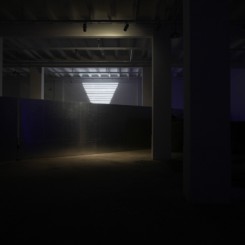“Who is Alone Now Will Stay Alone Forever,” solo exhibition by He An. Curator: Colin Chinnery (Qin Siyuan).
Location: 1st Floor, Building 5, 18 Wuwei Road, Putuo District, Shanghai. April 26 to May 25, 2012.
Karen Smith: The first question relates to when we initially met. You were in the process of preparing a work for the Third Shenzhen Annual Sculpture Exhibition. It was of a form that was tied to the nature of the moment, especially in its content which reflected the zeitgeist. How did you conceive of the work?
Second, from that time to now, you have always produced works of a particular type that are in many respects different from those of other artists around you. Many of those works have been progressive, conceptually and in terms of content and form. None was easy to realize; most were expensive to produce. So what compelled you to keep going? What ambition that sustained you through the process of producing so many difficult and complex works?
He An: Missing You [the title of the work for the Shenzhen Annual Sculpture Exhibition] came about completely by chance. I was lucky that it came at the right time. It was a truly important, catalytic work for me as it had a wide impact. It was part of the Shenzhen Annual Sculpture Exhibition in 2000, curated by Yi Ying—I was put forward by Pi Li—but it wasn’t like the organisers were very impressed with my proposal at the time. They were looking for proper sculptures. There was no concept of installation at that time: I didn’t really understand what “installation” meant.
Also because we were just learning about the Internet then, just beginning to use it to communicate, we’d often say “missing you” when sending messages. From then on many of my works used language from the internet. So the inspiration for Missing You was tied to this language and means of communication.
In form, the work was a huge light box made of Perspex, shaped into the characters “Missing You, Please Call” and my phone number. It was 170 cm tall, six and a half meters long.
I felt that I didn’t really understand anything about Shenzhen. The first time I went, I had a feeling similar to the first time I went abroad. It was night; all I could see were the neon lights. It was amazing. It was like a real discovery. Apart from street lights, Beijing at night was nothing compared with Shenzhen, to the variety of those bright lights. Today, there is barely any difference between the lights in Beijing and Shenzhen, but back then there was a tremendous difference between north and south. It was 2000, after all — twelve years ago. The light in Shenzhen was different from anything I had seen. I wanted to try to capture that, to imbue it with my personal emotional response. That’s what Missing You was all about: I had no idea of post-modern, of installation; I just followed my instinct.
KS: Is it correct to say, as you just suggested in describing the inspiration for Missing You, that personal intuitive instinct is an important element in your work?
HA: It was certainly important for this debut. Missing You; Please Call Me had a big impact. People still remember it today: they tell me that they don’t have much impression of anything I did after that, but that first work they’ll never forget. It doesn’t matter if they understand art or not, this was a work that everyone liked.



